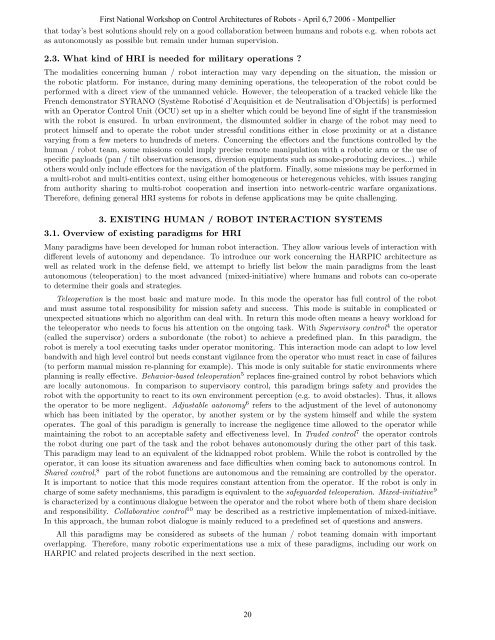Pleading for open modular architectures - Lirmm
Pleading for open modular architectures - Lirmm
Pleading for open modular architectures - Lirmm
Create successful ePaper yourself
Turn your PDF publications into a flip-book with our unique Google optimized e-Paper software.
First National Workshop on Control Architectures of Robots - April 6,7 2006 - Montpellier<br />
that today’s best solutions should rely on a good collaboration between humans and robots e.g. when robots act<br />
as autonomously as possible but remain under human supervision.<br />
2.3. What kind of HRI is needed <strong>for</strong> military operations ?<br />
The modalities concerning human / robot interaction may vary depending on the situation, the mission or<br />
the robotic plat<strong>for</strong>m. For instance, during many demining operations, the teleoperation of the robot could be<br />
per<strong>for</strong>med with a direct view of the unmanned vehicle. However, the teleoperation of a tracked vehicle like the<br />
French demonstrator SYRANO (Système Robotisé d’Acquisition et de Neutralisation d’Objectifs) is per<strong>for</strong>med<br />
with an Operator Control Unit (OCU) set up in a shelter which could be beyond line of sight if the transmission<br />
with the robot is ensured. In urban environment, the dismounted soldier in charge of the robot may need to<br />
protect himself and to operate the robot under stressful conditions either in close proximity or at a distance<br />
varying from a few meters to hundreds of meters. Concerning the effectors and the functions controlled by the<br />
human / robot team, some missions could imply precise remote manipulation with a robotic arm or the use of<br />
specific payloads (pan / tilt observation sensors, diversion equipments such as smoke-producing devices...) while<br />
others would only include effectors <strong>for</strong> the navigation of the plat<strong>for</strong>m. Finally, some missions may be per<strong>for</strong>med in<br />
a multi-robot and multi-entities context, using either homogeneous or heteregenous vehicles, with issues ranging<br />
from authority sharing to multi-robot cooperation and insertion into network-centric warfare organizations.<br />
There<strong>for</strong>e, defining general HRI systems <strong>for</strong> robots in defense applications may be quite challenging.<br />
3. EXISTING HUMAN / ROBOT INTERACTION SYSTEMS<br />
3.1. Overview of existing paradigms <strong>for</strong> HRI<br />
Many paradigms have been developed <strong>for</strong> human robot interaction. They allow various levels of interaction with<br />
different levels of autonomy and dependance. To introduce our work concerning the HARPIC architecture as<br />
well as related work in the defense field, we attempt to briefly list below the main paradigms from the least<br />
autonomous (teleoperation) to the most advanced (mixed-initiative) where humans and robots can co-operate<br />
to determine their goals and strategies.<br />
Teleoperation is the most basic and mature mode. In this mode the operator has full control of the robot<br />
and must assume total responsibility <strong>for</strong> mission safety and success. This mode is suitable in complicated or<br />
unexpected situations which no algorithm can deal with. In return this mode often means a heavy workload <strong>for</strong><br />
the teleoperator who needs to focus his attention on the ongoing task. With Supervisory control 4 the operator<br />
(called the supervisor) orders a subordonate (the robot) to achieve a predefined plan. In this paradigm, the<br />
robot is merely a tool executing tasks under operator monitoring. This interaction mode can adapt to low level<br />
bandwith and high level control but needs constant vigilance from the operator who must react in case of failures<br />
(to per<strong>for</strong>m manual mission re-planning <strong>for</strong> example). This mode is only suitable <strong>for</strong> static environments where<br />
planning is really effective. Behavior-based teleoperation 5 replaces fine-grained control by robot behaviors which<br />
are locally autonomous. In comparison to supervisory control, this paradigm brings safety and provides the<br />
robot with the opportunity to react to its own environment perception (e.g. to avoid obstacles). Thus, it allows<br />
the operator to be more negligent. Adjustable autonomy 6 refers to the adjustment of the level of autononomy<br />
which has been initiated by the operator, by another system or by the system himself and while the system<br />
operates. The goal of this paradigm is generally to increase the negligence time allowed to the operator while<br />
maintaining the robot to an acceptable safety and effectiveness level. In Traded control 7 the operator controls<br />
the robot during one part of the task and the robot behaves autonomously during the other part of this task.<br />
This paradigm may lead to an equivalent of the kidnapped robot problem. While the robot is controlled by the<br />
operator, it can loose its situation awareness and face difficulties when coming back to autonomous control. In<br />
Shared control, 8 part of the robot functions are autonomous and the remaining are controlled by the operator.<br />
It is important to notice that this mode requires constant attention from the operator. If the robot is only in<br />
charge of some safety mechanisms, this paradigm is equivalent to the safeguarded teleoperation. Mixed-initiative 9<br />
is characterized by a continuous dialogue between the operator and the robot where both of them share decision<br />
and responsibility. Collaborative control 10 may be described as a restrictive implementation of mixed-initiave.<br />
In this approach, the human robot dialogue is mainly reduced to a predefined set of questions and answers.<br />
All this paradigms may be considered as subsets of the human / robot teaming domain with important<br />
overlapping. There<strong>for</strong>e, many robotic experimentations use a mix of these paradigms, including our work on<br />
HARPIC and related projects described in the next section.<br />
20

















